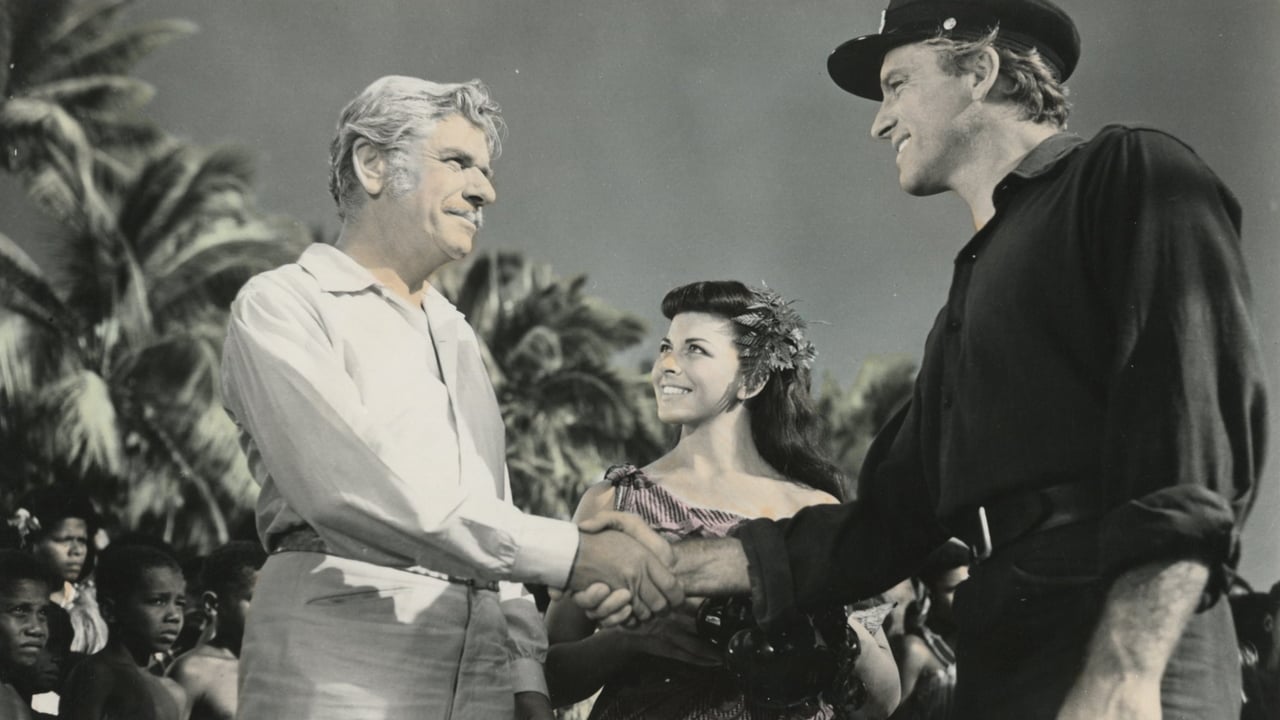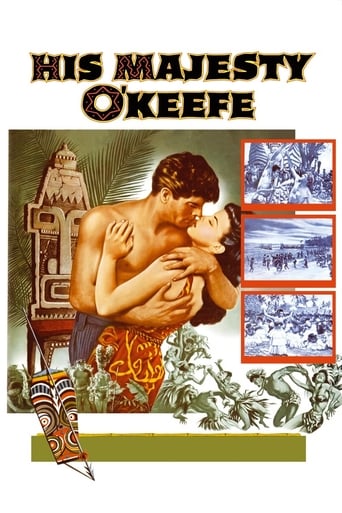

An average albeit unusual action adventure drama set in the South Seas (it was filmed on the Fiji islands) of the Pacific Ocean which stars Burt Lancaster, and hundreds of island natives. Additional support is provided by Joan Rice, André Morell, Abraham Sofaer, Archie Savage, Benson Fong, and Philip Ahn (among others). It was directed by Byron Haskin, and was written by Borden Chase and James Hill from a novel by Gerald Green and Lawrence Klingman.In the 1870s, coconut oil is a valuable resource which is derived from the dried meat or copra of the fruit. Lancaster plays a sea captain - the titled O'Keefe - and would-be copra trader that finds himself on the island of Yap after his hungry overworked crew were driven to mutiny by his greedy but unfulfilled quest.Yap is wrought with palm trees filled with coconuts that the local representative of a German trading company Alfred Tetins (Morell) has been unable to have harvested for the two decades that he's lived there. It seems that the native islanders can't be motivated to work; their only interest lies in FEI, large round stones that can only be obtained through great human cost from a distant island.Upon returning to Hong Kong, O'Keefe finds an unlikely partner in dentist Ahn, whose nephew (Fong) becomes the captain's first mate. When the crew of O'Keefe's "new" junk is near starvation, they happen upon the island where the Yap natives mine the FEI. It's there that O'Keefe meets the lovely daughter of an Englishman (Rice). While he doesn't force the captain to marry her, a shotgun wedding was initially threatened (later, a Hong Kong wedding is thrown for the couple by the dentist).Using gunpowder, O'Keefe shows the Yap medicine man (Sofaer) how much faster the FEI can be mined. This leads to a conflict between two tribal leaders, one (Savage) who believes that the traditional way of obtaining the stones in the only way and another (Tessa Prendergast) who strikes a trade agreement with O'Keefe.Naturally the Germans, that employ Tetins and a pirate aptly named Bully (Charles Horvath), aren't too happy with the arrangement. After Bully burns the Yap's huts and imprisons them, O'Keefe rescues the natives, who decide to make the captain their king.
... View MoreUnique & Great Movie if you like Burt Lancaster at his athletic finest...I did...OK, flimsy/iffy plot & but realistic to many of us who've never gotten to the South Pacific...Beautiful photography...In line with the masses' attitudes towards South Pacific natives at the time...They were still exotic...Although, this movie was filmed during thermo-nuclear tests in the South Pacific, especially by France & America...It shows the vast gap between two cultures & their inevitable clash...1st world capitalism greed versus 4th world innocents in their belief in the value of an absurd commodity...Whatever works to whoever's favor, as Burt's character proves...As his majesty, O'Keefe is humbled?, as he acquires his maiden (a beautiful, young, English turned native chick)...I like this movie...If you really think about it, given Burt Lancaster's life long & uncompromising liberal stance, then this movie is right up his alley as a statement during the McCarthy era political times...As a reality check in many ways, to those who might use the ultimate weapon of destruction, and the hell with anyone else who might be only able to kneel naked before their particular God...Long live Burt with his great physique as a younger man, and his forward looking political views which will last forever...Just like his unique films...
... View MoreThis is an amusing and fun movie , although heavily Hollywoodized, the film is based on real individuals and events . Here Burt Lancaster is the complete show , he played this adventure movie in the wake of his man-of-action epoch when he performed three magnificent movies that included ¨Crimson pirate¨ , ¨The Flame and the Arrow¨ and this one . Based on a real-life American adventurer , a Yankee sea captain who has adventures in paradise trying to become an entrepreneur in Micronesia. The entire picture was photographed in the South Pacific , where for years the basic economy and wealth revolved around the dried meat of coconut , known as Copra . And in the Island of Yap the natives worshipped an exotic sacred stone they called ¨Fei¨. It deals with Lancaster's attempts to make fame and fortune out of pearls or anything else he can lay his hands on , when he's not fighting gangs of pirates , he then became involved into the lucrative coconut-oil trade of the mid-1800s . There the disgruntled natives see him as a god and allow him to marry a charming maiden . When his kingdom is threatened by unscrupulous German traders , Burt springs into action to safeguard his kingdom .Agreeable as well as entertaining adventure movie , plenty of action , thrills , bright cinematography and exotic scenarios . Although the story has been told before , tight filmmaking and nice acting win out . The picture is fast-moving , exciting and thrilling ; however the scenic qualities of the movie are rather better than the disjointed screenplay by Borden Chase and James Hill , being suggested by a novel from Lawrence Klingman and Gerald Green . ¨His Majesty O'Keefe¨ results to be one of Lancaster's swashbuckling best and has achieved a good status along with ¨Crimson pirate¨(1952) and ¨The Flame and the Arrow¨(1950) , all of them made during star Burt Lancaster's athletic and swashbuckler period . Because of cost overruns on "The Crimson Pirate" and "His Majesty O'Keefe," Warner Brothers insisted that future films from Hecht/Lancaster be limited to $900,000 ; then Lancaster and Hecht's response was to strike a new deal with United Artists. The cast is frankly well such as Andre Morell as a friendly trader , Abraham Sofaer as a medicine man and a gorgeous young Joan Rice . The producers , the notorious team formed by Harold Hecht-James Hill-Lancaster wish to acknowledge their gratitude to the Secretary for Fijian Affairs , to Ratu Penaia La La Latiamara , Serua District Chief in Charge and to the wonderful people of the Fiji Islands . Colorful cinematography shot on location by Otto Heller , this was the first film ever filmed in the Fiji Islands . Lively and atmospheric musical score composed by the classic Dimitri Tiomkin , though the British print has a Robert Farnon score conducted by Louis Levy, re-scored in Hollywood by Dimitri . Lavishly produced and being professionally directed by Byron Haskin , though with no originality . Haskin was a good craftsman who worked in Warner Brothers Special Effects department . He returned to filmmaking , and was responsible for Walt Disney's first live-action film , the adventure cult-classic Treasure island (1950). In the mid-1950s Haskin began a rewarding association with producer George Pal, for whom he filmed what are probably his best-known films , the science fiction classic War of the worlds (1953) , Conquest of space (1955) and a catastrophe movie , The naked jungle (1954). Haskin was expert on Sci-Fi genre , as he would collaborate with Pal on other films , such as From the earth to moon , Robinson Crusoe on Mars (1964) and The power (1968). He also directed some Western as Denver Rio Grande and Silver City and especially adventure movie such as Treasure Island (1950) , Long John Silver (1954) , Captain Sinbad (1963) and this His Majesty O'Keefe (1954) .
... View MoreThis is a pretty fair action flick, with the usual stunts you'd expect from Lancaster. Having spent a full year on the glorious Isle of Yap in the mid 60's, (with the U.S. Coast Guard) I can tell you that if they had native girls that looked near as good as Ms. Rice there, I would not have been so anxious to leave!
... View More